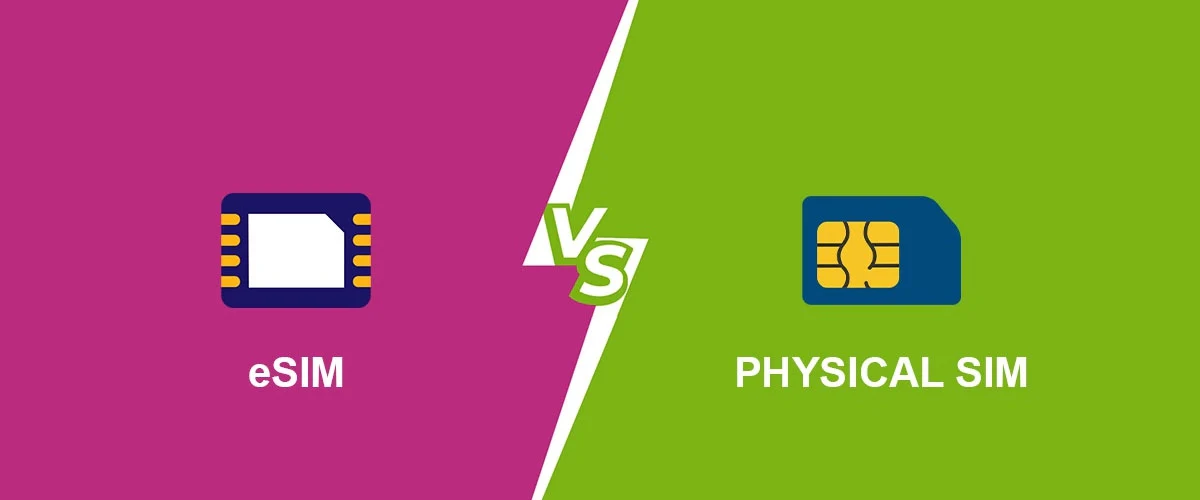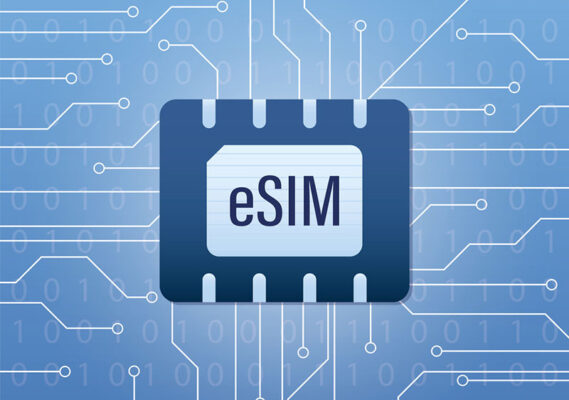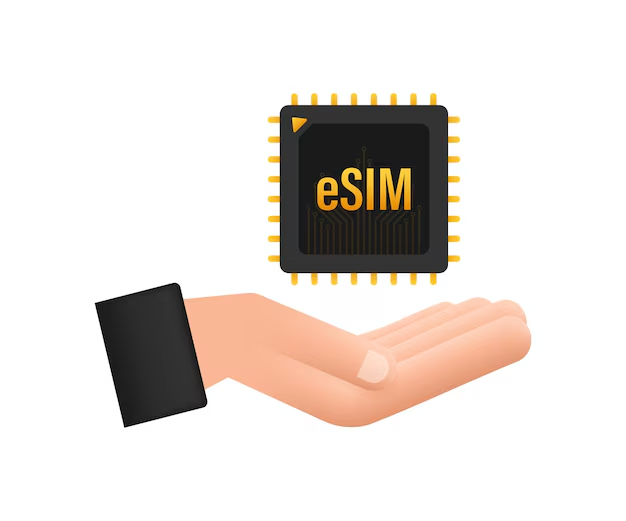In the rapidly changing world of mobile technology, you have probably already heard the term ‘eSIM’ in conjunction with the familiar ‘physical SIM’. They perform the same function – hooking up your phone to a mobile network – but work in a very different way.
In this article we’ll explain the main differences between eSIM and physical SIM, outline the pros and cons of each, and help you decide which is the right choice for your needs.

eSIM and Physical SIM Cards
1. What is a Physical SIM?
A SIM card is the small card you put in your phone to connect to a mobile network. It includes an exclusive number that enables your phone to connect to the network, and you need to change it when switching carriers or travelling abroad.
Advantages of Physical SIM:
Physical SIMs are universal: from smartphones to tablets to some laptops, almost every mobile device is built to work with a physical SIM card.
Plug & Play: insert the SIM card into your device and you’re ready to go. You don’t need to be technically savvy.
Carrier Portability: If you wish to switch carriers, you need only to replace the SIM card. This is very convenient when travelling abroad, or when looking for bargains.
Works on Older Phones: Physical SIM cards work on almost all mobile phones, including those old models that don’t support eSIM.
Disadvantages of Physical SIM:
Storage Limitation: A physical SIM card can hold only one carrier profile, so you can’t store multiple mobile plans or numbers on the same card.
Easy to Lose or Damage: Physical SIM cards can be easily lost or damaged, especially if you want to switch to a different carrier.
Travel problems: If you travel abroad, you may need to purchase a new SIM card in each country you visit. Switching SIM cards all the time can be a hassle.
Requires Manual Activation: When switching carriers or upgrading your device, you may have to manually activate or register the new SIM card.

2. What is an eSIM?
An eSIM (embedded SIM) is a digital SIM embedded in your phone or tablet. You needn’t insert or remove any cards to switch carrier or network plan. Instead, an eSIM enables you to store multiple operator profiles digitally and to switch between them as needed.
Advantages of eSIM:
Nothing to Lose: With an eSIM embedded in your phone, you can’t lose or damage a physical SIM card.
Several Profiles on One Device: An eSIM can hold multiple profiles, so you can switch between them. This is ideal for jetsetters or for someone who wishes to have two phone numbers from the same device (e.g. one for work and one for friends and family).
Convenience for Travellers: You can switch networks or add a local carrier’s plan digitally, without needing to buy a new physical SIM card. This can save time and roaming charges.
Simpler Design: Because eSIMs don’t need a SIM card tray, phones can be designed to be smaller, sleeker and more robust.
Future-Proofing: As the world digitalises, eSIM technology is gaining ground, with more new devices and carriers supporting it, so it’s a more forward-thinking choice.
Disadvantages of eSIM:
Not all devices support it: most new smartphones back eSIM, but older models, especially those older than 2018, don’t have this capability. Moreover, some devices - such as several budget phones - do not yet support eSIM.
Carrier Compatibility: eSIM isn’t supported by all carriers, so it may not work with your carrier. You’ll have to ask your carrier if they provide eSIM plans.
Setup Complexity: It’s convenient once set up, but activating an eSIM may require scanning a QR code or entering some technical details. This is sometimes more complicated than plugging in a physical SIM card, particularly for the less technologically adept.
Not Always User-Friendly: It may be more complicated to change carriers or eSIM profiles than to pop out a physical SIM. Activation and deactivation may require several more steps with some devices or carriers.
5 Key Differences Between SIM and eSIM
Both physical SIMs and eSIMs do the same basic job, but there are some important differences between them that might make one more suitable for your needs than the other.
Let’s compare them:
Feature | Physical SIM | eSIM |
Form Factor | Removable, physical card | Embedded in the device |
Carrier Switching | Need to swap cards | Can switch via settings |
Supported Devices | All mobile phones | Limited support on older models |
Convenience | Can be a hassle to swap | No need to swap, easy to manage multiple plans |
Durability | Prone to damage or loss | No physical risk |
Which is Better: eSIM or Physical SIM?
After learning about the characteristics, advantages and disadvantages of physical SIMs and eSIMs, you may be left wondering which is the right choice for you. Ultimately, the answer depends on your personal requirements, how you use your phone – and whether your device has eSIM capabilities.
Both SIMs do the same job, you’ll just have a different experience depending on which you choose. Let’s examine the two parts more closely.

Factors to Consider When Choosing Between eSIM and Physical SIM:
1. Device Compatibility
If you’re using an old phone or a device that doesn’t support eSIM, you can use only a physical SIM.
But if you have a newer model – an iPhone XS or later, or select Androids – an eSIM might offer you more flexibility.
2. Convenience and Flexibility
If you prefer an easy, smooth life, eSIM is the obvious choice. You can have several carrier accounts on a single device and switch between them at will, so you don’t have to take out the SIM card when you travel or switch networks.
On the other hand, if you change phones often or travel to places where eSIM isn’t supported, a physical SIM card may still be more convenient.
3. International Travel
ESIM can be super convenient for frequent travellers. You can switch between local operators or between international plans with a flick of a digital switch, rather than purchasing a new SIM card every time you land in a new country.
For physical SIM users, it is a more time-consuming process and may require buying new SIM cards at different destinations.
4. Cost and Availability
Physical SIMs are ubiquitous in stores and kiosks worldwide, but eSIM support is growing. But locating an eSIM plan may not be so simple, depending on your location and carrier.
Yet eSIMs are often cheaper, and enable customers to dodge roaming fees by switching to a local carrier plan.
5. Securit
Encryption protects both eSIM and physical SIM cards, but as eSIMs are embedded in the device, they have a slight edge in terms of security against theft or tampering.
There is no need to remove or replace any physical card, so it’s harder for someone to steal or misuse your SIM.
6. Switching Between Carriers
If you often switch your mobile service provider or have a second phone number for business, eSIM spares you the need to change a physical card each time. Your device just needs to refresh the eSIM profile.
But if you like the flexibility of being able to change the SIM card manually and you’re a bit of a traditionalist, you may still prefer a physical SIM card.
FAQ
1. Can I have an eSIM and a physical SIM in the same phone?
Indeed, many of today’s phones have both an eSIM and a physical SIM card, so you can have two carriers or two lines.
2. If my phone has a physical SIM, can I still use an eSIM?
That depends on your device and your carrier. Most newer phones have eSIMs, but you’ll need to check with your carrier.
3. Can I get an eSIM anywhere in the world?
Although the use of eSIMs is on the rise, many countries and carriers do not yet support the technology. But first make sure your carrier provides eSIM services.

4. Will I be able to keep my physical SIM card if I switch to an eSIM?
In fact, most devices can use an eSIM and a physical SIM at the same time, so that you can keep your old number and plan while adding a new one.
5. Is my Device eSIM-Enabled?
Most models support eSIM. If your device can use eSIM, look for this in your device’s specifications or settings.
Conclusion
Whether you prefer a physical SIM or an eSIM depends on you and your device. Neither choice is perfect, but eSIMs are definitely making the mobile world a more convenient and efficient place.
The choice between a physical SIM and an eSIM depends on your lifestyle and needs.
